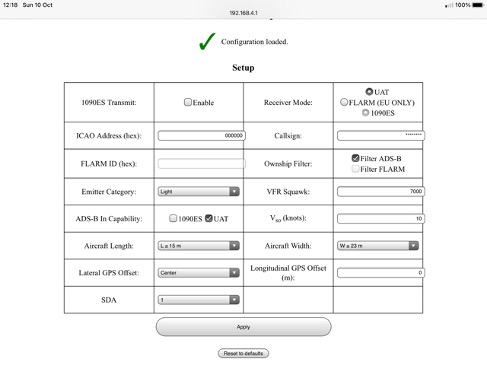SkyEcho – UK TIS-B Trial Guidance

In a TIS-B environment, it is important that users of Electronic Conspicuity devices and Electronic Flight Bag applications correctly populate them with the callsign and unique ICAO Hex code allocated by the National regulator to an aircraft. This includes installed EC devices, such as transponders and Traffic Alerting Systems, as well as dual-band capable (UAT and 1090MHz) carry-on systems such as SkyEcho.
In a single-band ADS-B environment, 1090MHz outside of the USA, it is normally only necessary to guard one frequency against a receiver alarming against the output from the aircrafts own transponder (be it ADS-B or simple Mode S) or ADS-B transmissions from the transmitter side of an ADS-B transceiver. This signal emitted by the device(s) is known as Ownship.
To prevent a false alarm either the EC receiver itself or the associated EFB (and sometimes both) are provided with the aircrafts allocated Hex code via user input during the setup process. When traffic signals are received in the EC device, the Hex codes of the traffic are compared with the known Ownship Hex; if they are the same the traffic is not passed on to the EFB. The process also occurs as the traffic data passes from the EC receiver to the EFB and if the same as Ownship, the traffic is not passed for display. The EC device is either receiving the output from the aircrafts transponder or the transmitter part of an ADS-B transceiver (both have the same Hex Code) and so filters it out. This filtering prevents the display of a Ghost traffic track of the Ownship very close by and which could generate an alarm.
Under TIS-B, traffic data is received by the ground-based receiver network and is rebroadcast to capable receivers on the Universal Access Transceiver frequency of 978MHz (within the internationally protected aeronautical band). Before transmission, the received data is compared across sources; normally Mode S and ADS-B, but can include other EC systems such as FLARM. If the system correlates a Mode S source with an ADS-B source then MLAT is not carried out at that point and only the ADS-B position is passed for rebroadcast over UAT. Similarly, if there is no associated Mode S signal because an aircraft has only an ADS-B transceiver and no transponder, then the ADS-B position data will be passed for rebroadcast over UAT. Should the system lose an ADS-B track, but be receiving Mode S from the same aircraft, then it will conduct MLAT and pass the data for transmission via UAT.
At the receiver end of a TIS-B broadcast, a dual-band traffic receiver will receive traffic data on the UAT frequency and pass it on to the EFB. It will though first filter for Ownship Hex and the EFB will do likewise in order to filter out the Ownship signal (which could be from the aircrafts transponder) returning via UAT and so prevent a self alarm. SkyEcho is preset to prioritize ADS-B traffic received over 1090MHz and so will pass that to the EFB for display in preference to the same track received via UAT.
Unfortunately under TIS-B, incorrect configuration by the user can thwart the safeguards, if they for instance do any of the following:
- Mistype the Hex code into either the EC device or the EFB
- Select the wrong aircraft from an EFBs pre-populated aircraft library.
- Do not completely populate an EFB aircraft library to include Hex Code.
- Take an EC device configured for another aircraft into one which has a transponder.
Whilst it is good practice using EC equipment to always fully populate your devices and EFB with the correct Ownship Hex, it is particularly important to do so under TIS-B.

If you are using a SkyEcho and want to receive TIS-B traffic then you should make sure that the SkyEcho Setup page (192.168.4.1/setup) shows:
- Receiver Mode: set to UAT
- ICAO Address (hex): set for your aircraft
- Callsign: set for your aircraft (No hyphens or spaces)
- Ownship Filter: set ON
- ADS-B In Capability: set to UAT
You will then receive TIS-B broadcast where it is available. Finally, SkyDemon advises that you should update to Version 3.15.5 if using TIS-B.